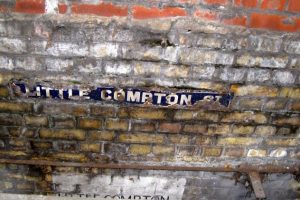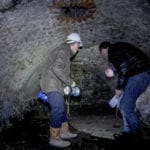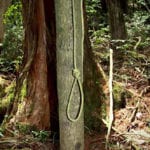 Weird Stuff
Weird Stuff  Weird Stuff
Weird Stuff  Animals
Animals 10 Inspiring Tales of Horses Being Human
 Mysteries
Mysteries Top 10 Haunting Facts About the Ghost Ship MV Alta
 History
History 10 Surprising Stories About the Texas Rangers
 Humans
Humans 10 Philosophers Who Were Driven Mad by Their Own Theories
 Miscellaneous
Miscellaneous 10 Video-Game-Worthy Weapons and Armors from History
 Weird Stuff
Weird Stuff 10 Psychics Who Accurately Predicted Wartime Events
 The Arts
The Arts 10 Pieces of Art Inspired by a Broken Heart
 Health
Health 10 Science Fiction-Sounding New Medical Treatments
 History
History 10 Surprising Facts About the Father of Submarine Warfare
 Weird Stuff
Weird Stuff 10 Times Real Laws Were Based on Bizarre Hypotheticals
 Animals
Animals 10 Inspiring Tales of Horses Being Human
 Mysteries
Mysteries Top 10 Haunting Facts About the Ghost Ship MV Alta
Who's Behind Listverse?

Jamie Frater
Head Editor
Jamie founded Listverse due to an insatiable desire to share fascinating, obscure, and bizarre facts. He has been a guest speaker on numerous national radio and television stations and is a five time published author.
More About Us History
History 10 Surprising Stories About the Texas Rangers
 Humans
Humans 10 Philosophers Who Were Driven Mad by Their Own Theories
 Miscellaneous
Miscellaneous 10 Video-Game-Worthy Weapons and Armors from History
 Weird Stuff
Weird Stuff 10 Psychics Who Accurately Predicted Wartime Events
 The Arts
The Arts 10 Pieces of Art Inspired by a Broken Heart
 Health
Health 10 Science Fiction-Sounding New Medical Treatments
 History
History 10 Surprising Facts About the Father of Submarine Warfare
10 Truly Unsettling Underground Places in the UK
The UK has no shortage of creepy locations. You can’t turn a corner without stumbling on a medieval pub, a Tudor mansion, or an ancient, crumbling abbey. And that is perhaps not too surprising, given that experts believe human beings have inhabited the UK for around 850,000 years.
But what about those spaces that the sunlight can’t reach? What about the caves and caverns, the buried settlements, or the abandoned structures deep inside the earth? These places of darkness and mystery are more common than you might think. After all, do any of us really have any idea what lies beneath the streets we walk every day?
Here we explore ten truly unsettling underground places in the UK.
Related: Top 10 Secret Tunnels And Underground Passageways In Ireland
10 Hellfire Caves
Atop a sunny hillside in Buckinghamshire, England, sits a harmless-looking church and mausoleum surrounded by rolling countryside. What the casual observer might not realize is that beneath this hill, deep inside the earth, lies a very old network of hand-hewn tunnels and chambers. They are reputed to have been used for very dark purposes in the 18th century by their creator, Sir Francis Dashwood.
Dashwood had a lot of money and, apparently, far too much time on his hands. He came up with a plan to expand the existing network of caves under his land and created a secret underground space, which he used to host gatherings of his infamous “Hellfire Club.” This secretive members-only group was rumored to engage in all manner of unchristian vices, including monk-themed sex parties, pagan rituals, and even human sacrifice. We’ll never know exactly what they got up to because the club’s secretary, Paul Whitehead, made a point of burning the records on his deathbed.
You can visit the Hellfire Caves today and explore Dashwood’s elaborate creation, which includes a Great Hall and an Inner Temple. Did you know that Benjamin Franklin was good friends with Dashwood and visited the caves himself on more than one occasion? The mind boggles![1]
9 Mary King’s Close
Edinburgh, Scotland, isn’t short of a ghost story or two. With its gloriously ancient castle, its myriad of dark, shadowy alleyways, and its time-worn cobbled streets, any visitor would be forgiven for feeling a chill even on the brightest of summer days. But the real horrors lie beneath.
The city’s Old Town is famously built over a maze of hidden vaults and chambers, which were once slums and tenements housing Edinburgh’s poor. Life in the slums was miserable, overcrowded, and dangerous, with crime and disease running rife. Space was sparse, and families lived nose-to-nose, sharing one-room houses where they lived, ate, and slept. In an attempt to expand, residents built upward. Some buildings reached 14 stories high. As the city developed and modernized, the slums were built over and eventually sealed off. It wasn’t until the 1980s that they were rediscovered, and many are now open to the public.
Mary King’s Close is a completely preserved 17th-century street, now deep underground, which has been open for visitors since 2003. The close was named after a fabric merchant who was widowed with four children and forced to make her own way in the world. She bought two properties on the close—a house and a stall—and became a prominent and well-respected trader. During Mary’s time on the close, it was the second-largest street in Edinburgh, overshadowed only by the Royal Mile![2]
8 Secret Wartime Tunnels, Dover
Deep beneath Dover Castle lies a network of man-made tunnels reaching out into the White Cliffs. Some of these tunnels are so old they date back to medieval times, and they were built and used throughout history in times of war and conflict.
During World War II, the area in and around Dover became central to the defense of the country, especially after France fell to Nazi soldiers in 1940. Old tunnels were re-purposed, and new tunnels were built to house a naval base and army headquarters. It was from here that Operation Dynamo was coordinated, which evacuated 338,226 Allied troops from Dunkirk.
In 1941, officials built an underground hospital inside the White Cliffs to support the war effort. It was situated closer to the surface than the other tunnels for ease of access and was used to treat injured pilots and provide first aid to casualties of the nearby air raids in Dover. Situating the hospital deep underground was a genius move—it meant that the hospital was one of the few places not vulnerable to bombing or shelling, leaving staff safe to carry out their duties unhindered. It must have been a tad cramped, though![3]
7 City of Caves
Nottingham, England, has such a vast network of subterranean passages beneath its modern surface that it has been dubbed the City of Caves. In fact, it is home to the largest known network of caves in the UK—a staggering 800 have been discovered so far!
Evidence suggests that the caves were carved manually out of the sandstone and that people have been creating them, living in them, and working in them for thousands of years. Archaeologists are still finding artifacts from previous settlements to this day. Throughout history, the caves have been used as homes, alehouses, brothels, prisons, storehouses, breweries, escape routes, secret passages, and much more. A tannery operated there in medieval times, and during WWII, they were used as air raid shelters. One cave, which runs underneath the old John Player tobacco factory, is large enough to fit 8,000 people inside it!
Many modern pubs and bars in Nottingham have access to their very own caves where customers can raise a glass to spirits long departed. There’s no wonder that Nottingham was known in Ancient Britain as Tigguo Cobauc—meaning “Place of Caves.” [4]
6 Cheddar Caves
Cheddar Gorge in England is the largest gorge in the country at 400 feet (122m) deep. It is around a million years old and began forming during the last Ice Age. But for our purposes, the gorge is notable because it contains a vast cave network.
It’s estimated that humans have been inhabiting the Cheddar Caves in one form or another for 40,000 years. The oldest skeleton ever discovered in Britain was found there in 1903. Dubbed the “Cheddar Man,” he is believed to have died a staggering 10,000 years ago.
The Cheddar Caves are notable—and perhaps even controversial—because they contain evidence that human beings were once cannibals. Scientists have discovered 13,000-year-old bones covered in markings that suggested their owners had been eaten. Yikes![5]
5 Abandoned Tube Stations
London is a big place, and so is its tube network. Transport for London operates 272 underground stations in the city on 11 tube lines. But what commuters and tourists alike don’t always realize is that there are around 40 disused stations dotted around in the dark, screaming to be remembered.
Perhaps the most well-utilized is Aldwych station, which was closed in 1994 due to low passenger numbers. It’s a firm favorite with production companies, and the abandoned space has been used in several well-known film and television shows in recent years, including Sherlock and Atonement.
In fact, Aldwych station was used for more than just transport even when it was in operation. During WWI, the National Gallery’s priceless art collection was stored there for safekeeping, and during WWII, it housed artifacts belonging to the British Museum.[6]
4 Wogan Cavern
Pembroke Castle in Wales has a varied and colorful history. Dating back to 1093, it has long been a place of huge political importance and was the birthplace of Henry Tudor, father of Henry VIII. Uniquely, it was built directly over a large vault named Wogan Cavern, which has been around for much longer.
Artifacts found in the cavern date back to pre-historic times as well as Roman and Medieval eras. Experts believe that the cavern was inhabited by humans as far back as the last Ice Age. They’ve even found the bones of a woolly mammoth down there![7]
3 Churchill War Rooms
Tucked away deep beneath Westminster, London, just down the road from 10 Downing Street, lie the historic Churchill War Rooms. It was here that Churchill and his government coordinated the British war effort in WWII.
Visitors to the complex can explore the Churchill Museum and the Cabinet War Rooms to find out what life was like during WWII in the epicenter of the British government. You can even visit Churchill’s bedroom, which he used to entertain visitors and for his all-important afternoon naps. The bedroom is the only room in the complex to have fitted carpeting—quite the luxury![8]
2 Little Compton Street, London

Described as “London’s buried street,” you have to do a bit of digging (excuse the pun) to find Little Compton Street. In fact, the only way to see it is from the vantage point of a small traffic island in the middle of a busy road near Old Compton Street in Soho, London. If you can get to the middle of the road without being hit by a car (a feat in itself), you’ll need to squat low and peer through the island’s sewage grate, where you’ll get a tantalizing glimpse of an old Victorian-style street sign in the murky depths.
This buried and largely forgotten road was once at street level—a bustling thoroughfare that connected Old Compton Street and New Compton Street. In 1896, the area was remodeled to make room for the construction of Charing Cross Road, and Little Compton Street was built over. Sadly it’s now inaccessible, and an office block covers it.[9]
1 Lawrence Hill
A man named Dave Stephenson grew up hearing rumors of an abandoned Victorian street buried deep beneath Lawrence Hill in his hometown of Bristol, England. There was even a story that a man had drunkenly fallen down a tunnel while making his way home from the pub and had been very puzzled to find himself instantly transported back to Victorian England.
In 1999, Dave decided to investigate—and he discovered that the rumors were, in fact, very true. The street had been built over in the late 1800s during the construction of new railway lines. Some of the photos from his visit are truly fascinating, showing abandoned shop fronts and long-forgotten back rooms stuffed with old bikes, ladders, furniture, and picture frames. He even found an antique wheelchair.
Our knowledge of the true extent of this underground time capsule is frustratingly limited because the site is too dangerous to explore safely and is currently off-limits. Even Dave’s original entry route has been closed off.[10]








